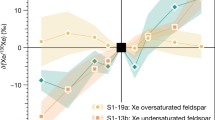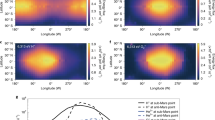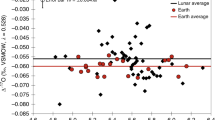Abstract
For five days of each lunar orbit, the Moon is shielded from solar wind bombardment by the Earth’s magnetosphere, which is filled with terrestrial ions. Although the possibility of the presence of terrestrial nitrogen and noble gases in lunar soil has been discussed based on their isotopic composition1, complicated oxygen isotope fractionation in lunar metal2,3 (particularly the provenance of a 16O-poor component) remains an enigma4,5. Here, we report observations from the Japanese spacecraft Kaguya of significant numbers of 1–10 keV O+ ions, seen only when the Moon was in the Earth’s plasma sheet. Considering the penetration depth into metal of O+ ions with such energy, and the 16O-poor mass-independent fractionation of the Earth’s upper atmosphere6, we conclude that biogenic terrestrial oxygen has been transported to the Moon by the Earth wind (at least 2.6 × 104 ions cm−2 s−1) and implanted into the surface of the lunar regolith, at around tens of nanometres in depth3,4. We suggest the possibility that the Earth’s atmosphere of billions of years ago may be preserved on the present-day lunar surface.
This is a preview of subscription content, access via your institution
Access options
Access Nature and 54 other Nature Portfolio journals
Get Nature+, our best-value online-access subscription
$29.99 / 30 days
cancel any time
Subscribe to this journal
Receive 12 digital issues and online access to articles
$119.00 per year
only $9.92 per issue
Buy this article
- Purchase on Springer Link
- Instant access to full article PDF
Prices may be subject to local taxes which are calculated during checkout



Similar content being viewed by others
References
Ozima, M. et al. Terrestrial nitrogen and noble gases in lunar soils. Nature 436, 655–659 (2005).
Hashizume, K. & Chaussidon, M. A non-terrestrial 16O-rich isotopic composition for the protosolar nebula. Nature 434, 619–622 (2005).
Ireland, T. R., Holden, P., Norman, M. D. & Clarke, J. Isotopic enhancements of 17O and 18O from solar wind particles in the lunar regolith. Nature 440, 776–778 (2006).
Hashizume, K. & Chaussidon, M. Two oxygen isotopic components with extra-selenial origins observed among lunar metallic grains — in search for the solar wind component. Geochim. Cosmochim. Acta 73, 3038–3054 (2009).
Ozima, M., Yin, Q.-Z., Podosekc, F. A. & Miura, Y. N. Toward understanding early Earth evolution: Prescription for approach from terrestrial noble gas and light element records in lunar soils. Proc. Natl Acad. Sci. 105, 17654–17658 (2008).
Thiemens, M. H. Atmospheric science: Mass-independent isotope effects in planetary atmospheres and the early solar system. Science 283, 341–345 (1999).
Saito, Y. et al. In-flight performance and initial results of Plasma energy Angle and Composition Experiment (PACE) on SELENE (Kaguya). Space Sci. Rev. 154, 265–303 (2010).
Tanaka, T. et al. First in situ observation of the Moon-originating ions in the Earth’s magnetosphere by MAP-PACE on SELENE (Kaguya). Geophys. Res. Lett. 36, L22106 (2009).
Yokota, S. et al. First direct detection of ions originating from the Moon by MAP-PACE IMA onboard SELENE (Kaguya). Geophys. Res. Lett. 36, L11201 (2009).
Seki, K., Elphic, R. C., Hirahara, M., Terasawa, T. & Mukai, T. On atmospheric loss of oxygen ions from Earth through magnetospheric processes. Science 291, 1939–1941 (2001).
Del Zanna, G. et al. CHIANTI — an atomic database for emission lines. Version 8. Astr. Astrophys. 582, A56 (2015).
Gloeckler, G. et al. Investigation of the composition of solar and interstellar matter using solar wind and pickup ion measurements with SWICS and SWIMS on the ACE spacecraft. Space Sci. Rev. 86, 497–539 (1998).
Wargelin, B. J. et al. Chandra observations of the ‘dark’ Moon and geocoronal solar wind charge transfer. Astrophys. J. 607, 596–610 (2004).
Seki, K. et al. Statistical properties and possible supply mechanisms of tailward cold O+ beams in the lobe/mantle regions. J. Geophys. Res. 103, 4477–4489 (1998).
Kistler, L. M. et al. Escape of O+ through the distant tail plasma sheet. Geophys. Res. Lett. 37, L21101 (2010).
Reisenfeld, D. B. et al. Elemental abundances of the bulk solar wind: Analyses from Genesis and ACE. Space Sci. Rev. 130, 79–86 (2007).
Ilie, R. & Liemohn, M. W. The outflow of ionospheric nitrogen ions: A possible tracer for the altitude dependent transport and energization processes of ionospheric plasma. J. Geophys. Res. Space Phys. 121, 9250–9255 (2016).
Yau, A. W., Abe, T. & Peterson, W. K. The polar wind: Recent observations. J. Atmos. Sol. Terr. Phys. 69, 1936–1983 (2007).
Mauersberger, K. Measurement of heavy ozone in the stratosphere. Geophys. Res. Lett. 8, 935–937 (1981).
Hiraki, Y., Yamada, A., Kasai, Y., Seta, T. & Ozima, M. Evaluation of isotopic fractionation of oxygen ions escaping from terrestrial thermosphere. Geochim. Cosmochim. Acta 84, 525–533 (2012).
Chappell, C. R. et al. The adequacy of the ionospheric source in supplying magnetospheric plasma. J. Atmos. Sol. Terr. Phys. 62, 421–436 (2000).
Ziegler, J. F. SRIM-2003. Nucl. Instrum. Meth. Phys. Res. B 219–220, 1027–1036 (2004).
Young, E. D. et al. Oxygen isotopic evidence for vigorous mixing during the Moon-forming giant impact. Science 351, 493–496 (2016).
McKeegan, K. D. et al. The oxygen isotopic composition of the Sun inferred from captured solar wind. Science 332, 1528–1532 (2011).
Anbar, A. D. et al. A whiff of oxygen before the great oxidation event? Science 317, 1903–1906 (2007).
Acuña, M. H. et al. Magnetic field and plasma observations at Mars: Initial results of the Mars Global Surveyor Mission. Science 279, 1676–1680 (1998).
Harada, Y. et al. Marsward and tailward ions in the near-Mars magnetotail: MAVEN observations. Geophys. Res. Lett. 42, 8925–8932 (2015).
Hale, C. J. The intensity of the geomagnetic field at 3.5 Ga: Paleointensity results from the Komati Formation, Barberton Mountain Land, South Africa. Earth Planet. Sci. Lett. 86, 354–364 (1987).
Kahn, P. G. K. & Pompea, S. M. Nautiloid growth rhythms and dynamical evolution of the Earth–Moon system. Nature 275, 606–611 (1978).
Jakosky, B. M. et al. MAVEN observations of the response of Mars to an interplanetary coronal mass ejection. Science 350, 6261 (2015).
Yokota, S., Saito, Y., Asamura, K. & Mukai, T. Development of an ion energy mass spectrometer for application on board three-axis stabilized spacecraft. Rev. Sci. Instrum. 76, 014501 (2005).
Saito, Y. & Mukai, T. The method of calculating absolutely calibrated ion and electron velocity moments. ISAS Res. Note 815, 1–23 (2007)
Yokota, S. & Saito, Y. Estimation of picked-up lunar ions for future compositional remote SIMS analyses of the lunar surface. Earth Planet. Space 57, 281–289, (2005).
Halekas, J. S., Saito, Y., Delory, G. & Farrell, W. M. New views of the lunar plasma environment. Planet. Space Sci. 59, 1681–1694 (2011).
Acknowledgements
We thank all the members of the SELENE project. This work was partly supported by Japan Society for the Promotion of Science (JSPS) KAKENHI Grants (No. 26800258, 26610183 and 22224010), the Mitsubishi Foundation and Yamada Science Foundation. Our discussion was partially supported by the project entitled “On-Site Mass Spectrometry Based on the Multi-Turn Time-of-Flight Mass Spectrometer ‘MULTUM’ (PI: Michisato Toyoda)” in a Support Program for Osaka University Future Research Initiative.
Author information
Authors and Affiliations
Contributions
K.T. and S.Y. wrote the manuscript. S.Y. also analysed the data, and contributed to the observations and data processing. Y.S., K.A. and M.N.N. contributed to the observations and data processing. N.K. contributed to the discussion.
Corresponding author
Ethics declarations
Competing interests
The authors declare no competing financial interests.
Rights and permissions
About this article
Cite this article
Terada, K., Yokota, S., Saito, Y. et al. Biogenic oxygen from Earth transported to the Moon by a wind of magnetospheric ions. Nat Astron 1, 0026 (2017). https://doi.org/10.1038/s41550-016-0026
Received:
Accepted:
Published:
DOI: https://doi.org/10.1038/s41550-016-0026
This article is cited by
-
A plasma irradiation system optimized for space weathering of solar system bodies
Earth, Planets and Space (2023)
-
Formation of lunar surface water associated with high-energy electrons in Earth’s magnetotail
Nature Astronomy (2023)
-
Ubiquitous and progressively increasing ferric iron content on the lunar surfaces revealed by the Chang’e-5 sample
Nature Astronomy (2023)
-
Future Directions for the Investigation of Surface-Bounded Exospheres in the Inner Solar System
Space Science Reviews (2023)
-
Distribution of water phase near the poles of the Moon from gravity aspects
Scientific Reports (2022)



